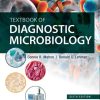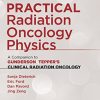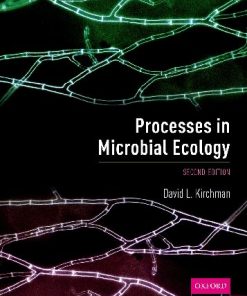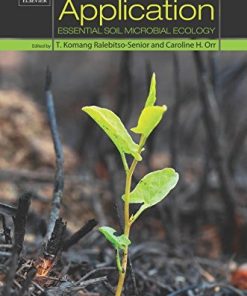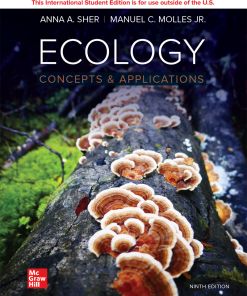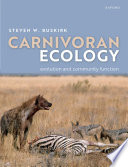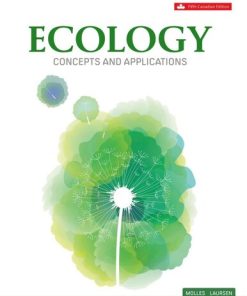Producing safe eggs microbial ecology of salmonella 1st Edition by Steven Ricke 0128026779 9780128026779
$50.00 Original price was: $50.00.$25.00Current price is: $25.00.
Producing safe eggs: microbial ecology of salmonella 1st Edition by Steven C Ricke – Ebook PDF Instant Download/DeliveryISBN: 0128026779, 9780128026779
Full download Producing safe eggs: microbial ecology of salmonella 1st Edition after payment.

Product details:
ISBN-10 : 0128026779
ISBN-13 : 9780128026779
Author: Steven C Ricke
Producing Safe Eggs: Microbial Ecology of Salmonella takes the unique approach of interfacing problems of Salmonella and microbial contamination with commercial egg production. It presents in-depth information on microbial contamination, safety and control, physiology, immunology, neurophysiology, and animal welfare, which makes this book a complete reference for anyone involved in the safe production of eggs and egg products in the food industry.
This book discusses management and risk factors across the entire egg production process, including practical applications to decrease disease and contaminated food products in poultry houses, processing plants and retail businesses. It is an integral reference for food scientists, food safety and quality professionals, food processors, food production managers, and food business owners, as well as students in food science, safety, microbiology, and animal science.
Producing safe eggs: microbial ecology of salmonella 1st Table of contents:
Section 1. Salmonella in Egg Production Systems: International Prevalence, Issues, and Challenges
Chapter 1. Of Mice and Hens—Tackling Salmonella in Table Egg Production in the United Kingdom and Europe
1. Salmonella Control in Table Egg Production in Europe
2. Infection Dynamics and Risk Factors for Acquisition/Persistence of Salmonella in Laying Hen Farms
3. Focal Points of Control for Salmonella in Laying Hen Farms
4. Concluding Remarks
Chapter 2. Microbiology of Shell Egg Production in the United States
1. Introduction: Salmonella and Eggs: A Public Health and Economic Problem
2. Salmonella Enteritidis and Laying Hens: Infection and Egg Contamination
3. Infection of Laying Hens and Egg Contamination by Different Salmonella Strains and Serotypes
4. Environmental Influences on Salmonella Infections in Egg-Laying Flocks
5. Egg Production Housing Systems and Salmonella
6. Controlling Salmonella Infection and Egg Contamination in Laying Flocks
7. Conclusions
Chapter 3. Egg Production Systems and Salmonella in Korea
1. Egg Production Industry: Overview
2. Size and Distribution of Egg-Laying Flocks
3. Egg Production Systems: HACCP and Egg Grading System in Korea
4. Epidemiology of Salmonella in Korea
5. Eggs and Salmonella
6. The Future of the Egg-Producing Poultry Industry in Korea
Chapter 4. Egg Production Systems and Salmonella in Canada
1. Egg Production Systems in Canada
2. Roles and Responsibilities
3. Control of Salmonella in the Canadian Egg Supply
4. National Salmonella Control Program—Start Clean-Stay Clean
5. Egg Grading Stations
6. Other Sources of Table Eggs—Surplus Broiler Hatching Eggs
7. Other Sources of Table Eggs—Unregulated Flocks
8. Is the System Working?
Chapter 5. Egg Production Systems and Salmonella in Australia
1. Egg Production Systems in Australia
2. Salmonella Outbreaks Associated With Eggs
3. Epidemiology of Salmonella on Australian Commercial Egg Farms
4. Prevalence and Eggshell Penetration by Salmonella
5. Human Factor in Salmonella Virulence Factors
6. Current On-Farm Control Measures With Focus on Egg Washing
7. Salmonella Control Measures and Limitations
Chapter 6. Egg Production Systems and Salmonella in South America
1. Introduction
2. Argentina
3. Bolivia
4. Brazil
5. Chile
6. Colombia
7. Ecuador
8. Paraguay
9. Peru
10. Guyana and Suriname
11. Uruguay
12. Venezuela
13. Conclusions
Section 2. Salmonella Contamination in Layer Flocks: Pathogenesis, Dissemination, and Current Control Strategies
Chapter 7. Overview of Salmonellosis and Food-borne Salmonella: Historical and Current Perspectives
1. Introduction
2. Historical Development of Salmonellosis
3. Poultry- and Poultry Products–Associated Salmonella
4. Summary and Conclusions
Chapter 8. Salmonella in Preharvest Chickens: Current Understanding and Approaches to Control
1. Introduction: General Salmonella Infection Biology
2. Biology of Layer Infections
3. Approaches to Control
4. Conclusion and Synthesis
Chapter 9. Developments in Detection Strategies for Salmonella Enteritidis in Layer Hen Flocks
1. Introduction
2. General Detection Strategies
3. Sample Types and Sample Collection
4. Culture Methods
5. Rapid Detection Methods
6. Conclusion
Chapter 10. Genetic Basis of Salmonella Enteritidis Pathogenesis in Chickens
1. Introduction
2. Infection Kinetics of SE in Chickens
3. Genetic Basis of SE Pathogenesis
Chapter 11. The Relationship Between the Immune Response and Susceptibility to Salmonella enterica Serovar Enteritidis Infection in the Laying Hen
1. Introduction
2. Overview of the Avian Immune System
3. Immunity in the Hen Reproductive Tract
4. Immune Response of the Laying Hen Reproductive Tract to Salmonella Infection
5. Host and Bacterial Factors That Contribute to Asymptomatic S. Enteritidis Colonization of Reproductive Tract
6. Bacterial Factors
7. Host Factors
8. Conclusions and Future Direction
Chapter 12. Salmonella Heidelberg in Layer Hens and Egg Production: Incidence and Potential Issues
1. Introduction
2. Emergence of Salmonella Heidelberg as a Food-borne Pathogen
3. Epidemiology of Egg-Associated Salmonella Outbreaks
4. Ecology of Salmonella Heidelberg Colonization and Invasion in Poultry
5. Virulence and Pathogenesis of Salmonella Heidelberg
6. Antimicrobial Resistance in Salmonella Heidelberg
7. Isolation, Identification, and Detection
8. Future Issues—Evolution of Salmonella Heidelberg
9. Conclusions
Section 3. Development of Specific Interventions for Salmonella in Laying Hens and Table Eggs: Present and Future Prospects
Chapter 13. Preharvest Measures to Improve the Safety of Eggs
1. Introduction: Salmonella and Eggs
2. Biosecurity Measures
3. Gastrointestinal Colonization Control
4. Vaccination
5. Alternative Preharvest Strategies to Control Salmonella in Poultry
6. Future Trends—Zero Salmonella Prevalence Concept?
Chapter 14. Current and Future Perspectives on Development of Salmonella Vaccine Technologies
1. Introduction
2. Challenges to Salmonella Control
3. Salmonella Control
4. Vaccination to Reduce Salmonella Enteritidis Infection in Layers
5. Live Attenuated Salmonella Vaccines
6. Inactivated Salmonella Vaccines
7. Salmonella Vaccination Programs
8. Recent Improvements in Enhancing Safety, Immunogenicity, and Efficacy of Live Salmonella Vaccines to Control Salmonella Infections in Poultry
9. Achieving the Balance Between Attenuation and Immunogenicity
10. Induction of Cross-protective Immunity Against Diverse Salmonella Serotypes and Closely Related Enteric Bacteria
11. Simultaneous Control of Salmonella Infection and Persistence by Control of Other Avian Colonizers and Pathogens
12. Improved Vaccination Practices for Ultimate Control of Persistence of Salmonella and Enteric Pathogens in Poultry to Enhance Poultry Health, Reduce Antibiotic Usage, and Ensure Food Safety
13. Summary
Chapter 15. Use of Direct-Fed Microbials in Layer Hen Production—Performance Response and Salmonella Control
1. Introduction
2. Microbial Competitive Enhancement Within the Gut
3. Probiotic Impacts in Chickens
4. Conclusions
Chapter 16. Gastrointestinal Ecology of Salmonella Enteritidis in Laying Hens and Intervention by Prebiotic and Nondigestible Carbohydrate Dietary Supplementation
1. Introduction
2. The Chicken GIT Microbiota
3. Laying Hen GIT Microbiota
4. Dietary Nondigestible Carbohydrate Mitigation Strategies—Molting Layer Hens
5. Prebiotics—Definition and General Concepts
6. Prebiotics—Layer Hens and Egg Production
7. Conclusions and Future Directions
Chapter 17. Preharvest Food Safety—Potential Use of Plant-Derived Compounds in Layer Chickens
1. Introduction
2. Salmonella—A Continuing Threat to Layer Safety
3. Plant-Derived Compounds
4. Antimicrobial Activity of PDCs in Broiler Chickens
5. Antimicrobial Activity of PDCs in Layers
6. Potential Mechanisms of Action of PDCs
7. Effect of PDCs on Production Parameters
8. Challenges With Using PDCs
9. Economic Considerations
10. Conclusion and Future Directions
Chapter 18. Chemical and Physical Sanitation and Pasteurization Methods for Intact Shell Eggs
1. Introduction
2. Washing
3. Electrolyzed Water
4. Pasteurization
5. Thermoultrasonication
6. Gas Plasma
7. Pulsed Light
8. Ozone
9. Ultraviolet Light
10. Irradiation
11. Storage to Minimize Growth
12. Conclusions
Chapter 19. Natural Approaches for Improving Postharvest Safety of Egg and Egg Products
1. Introduction
2. Major Contaminants in Eggs
3. Traditional Methods of Improving Egg Safety
4. Natural Approaches
5. Egg Products
6. Concluding Remarks
People also search for Producing safe eggs: microbial ecology of salmonella 1st:
salmonella is most frequently found on the inside of eggs
sale of eggs that are contaminated with salmonella
eggs are a potential source of salmonella bacteria
salmonella from eggs statistics
salmonella organic eggs
Tags: Producing, safe eggs, microbial ecology, salmonella, Steven Ricke
You may also like…
History - American Studies
Biology and other natural sciences
Biology and other natural sciences - Ecology
Biology and other natural sciences
Biology and other natural sciences - Ecology
Ecology: Concepts and Applications (Ninth Edition) Manuel C. Molles Jr.
Biology and other natural sciences
Carnivoran Ecology: The Evolution and Function of Communities Steven W. Buskirk
Biology and other natural sciences - Ecology
Carnivoran Ecology : The Evolution and Function of Communities Steven W. Buskirk
Biology and other natural sciences - Ecology
Ecology: Concepts And Applications 5th Edition by Manuel Molles 1260065812 978-1260065817


